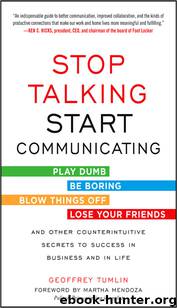Stop Talking, Start Communicating by Geoffrey Tumlin

Author:Geoffrey Tumlin [Tumlin, Geoffrey]
Language: eng
Format: epub, mobi
Publisher: McGraw-Hill Education
Published: 2013-01-01T23:00:00+00:00
Conversational Shock Absorbers
There are four shock-absorbing communication behaviors that smooth out the majority of common interpersonal hazards.
1. Let Go
Have you ever been able to work with someone when it seemed no one else could? Or talk to a relative who drives everyone else in your family crazy? Do you have close friends at work or at home who seriously irritate other people, but not you? If so, this success is almost certainly because you can ignore behaviors that other people can’t. You allow a do-over where other people insist on keeping score. That’s letting go, and it’s also the difference between my niece’s walks to school that end in laughter and the ones that end in tears.
When we let go of all but the most serious transgressions that touch us, we preempt damaging escalations and provide a chance for people to self-correct. You shouldn’t let serious breaches go, but most interpersonal hazards aren’t major. Letting go is communication’s equivalent of golf’s Mulligan—an errant stroke that doesn’t count against a golfer’s score. If you let people take a Mulligan when they need one, they’ll probably return the favor. In light of communication’s imperfectability (and human fallibility), you’ll both find that interpersonal do-overs come in handy.
And don’t worry that extending Mulligans will perpetuate bad behavior. In the unlikely event that someone seems to take advantage of your willingness to overlook the occasional mistake, you can always stop ignoring the behavior or have a direct conversation about the issue.
Although asynchronous communication makes conversational hazards more likely because of the lack of cues and delayed feedback, the good news is that it’s often easier to let go of asynchronous communication hazards. You can use the lag inherent in asynchronous communication between receiving a message and responding to avoid a knee-jerk reaction and to reply more thoughtfully. And when people can’t see you receiving a message, there is always a little uncertainty about whether it went through or whether you’ve seen it yet, which makes it easier to ignore. So whenever possible, let asynchronous conversational hazards die on the digital vine—take an e-Mulligan—by ignoring the mildly irritating e-mail, text message, or social media post.
You can also proactively use digital devices to insert shock-absorbing space between you and your conversational partner when it might be beneficial. A friend of mine, who acknowledges he has a temper, has an agreement with his wife to only communicate via text message when he’s upset. This keeps a line of communication open between them, but it gives him an asynchronous channel to constrain and delay his responses, the hope being to prevent him from saying something he’ll regret later. When he’s cooled off enough, they can continue their discussion face-to-face or by phone.
This example also provides a good opportunity to repeat an important point: our new communication devices don’t degrade our interactions; we do. It’s entirely possible—indeed, it’s the great promise of the digital communication revolution—to use digital devices in ways that improve our communication and strengthen (or prevent damage to) our most important relationships.
Download
Stop Talking, Start Communicating by Geoffrey Tumlin.mobi
This site does not store any files on its server. We only index and link to content provided by other sites. Please contact the content providers to delete copyright contents if any and email us, we'll remove relevant links or contents immediately.
| Bookkeeping | Business Mathematics |
| Business Writing | Communications |
| Decision Making | Negotiating |
| Project Management | Running Meetings & Presentations |
| Secretarial Aids & Training | Time Management |
| Training |
Nudge - Improving Decisions about Health, Wealth, and Happiness by Thaler Sunstein(7469)
Deep Work by Cal Newport(6826)
Principles: Life and Work by Ray Dalio(6137)
Factfulness: Ten Reasons We're Wrong About the World – and Why Things Are Better Than You Think by Hans Rosling(4635)
The Doodle Revolution by Sunni Brown(4625)
Eat That Frog! by Brian Tracy(4392)
Thinking in Bets by Annie Duke(4127)
Hyperfocus by Chris Bailey(4014)
Visual Intelligence by Amy E. Herman(3698)
Writing Your Dissertation in Fifteen Minutes a Day by Joan Bolker(3651)
How to Win Friends and Influence People in the Digital Age by Dale Carnegie & Associates(3472)
Ogilvy on Advertising by David Ogilvy(3464)
Hidden Persuasion: 33 psychological influence techniques in advertising by Marc Andrews & Matthijs van Leeuwen & Rick van Baaren(3421)
How to win friends and influence people by Dale Carnegie(3356)
The Pixar Touch by David A. Price(3336)
Schaum's Quick Guide to Writing Great Short Stories by Margaret Lucke(3286)
Deep Work: Rules for Focused Success in a Distracted World by Cal Newport(3073)
Work Clean by Dan Charnas(3013)
The Slow Fix: Solve Problems, Work Smarter, and Live Better In a World Addicted to Speed by Carl Honore(2917)
